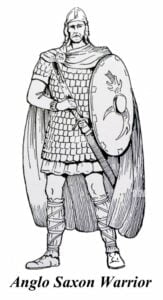During this period England was open to be conquered by any north European tribe, therefore the Germans, the Vikings and then the Danish invaded.
First came the Germans
 As soon as the Romans left in 410AD we started to be invaded by raiding parties of Germans. It wasn’t a large invasion, just tribes, such as the Jutes, Angles, and Saxons, who were basically looking for new lands on which to settle.
As soon as the Romans left in 410AD we started to be invaded by raiding parties of Germans. It wasn’t a large invasion, just tribes, such as the Jutes, Angles, and Saxons, who were basically looking for new lands on which to settle.
They became known as Anglo Saxons and they first landed in Eastern Britain. Unfortunately, there are few records of this period. Anglo-Saxons were already living in Britain before the Romans left, most served in the Roman army fighting the Saxon pirates. These Saxon raiding parties were regularly raiding the southern and eastern coasts of Britain from the 3rd century onwards.
Then the local tribal leaders used these Anglo-Saxons as mercenaries fighting the invasions of the Picts in the first half of the fifth century. The Picts became less of a threat, but the Anglo-Saxon mercenaries stayed and then encouraged others to come and join them.
Viking raids and invasions
Viking raids started in the end of the 8th century, starting with monasteries. The first monastery raided was Lindisfarne in 793, even though it is thought that the first one was actually in 789 at Portland in Devon.
 They targeted monasteries and minster churches for the simple reason that they were wealthy and usually had valuable artifacts that were portable.
They targeted monasteries and minster churches for the simple reason that they were wealthy and usually had valuable artifacts that were portable.
The locals were not happy but kept losing to their Norse men attackers. “The Anglo-Saxon Chronicle for the year 840” says that Æthelwulf of Wessex was defeated at Carhampton, Somerset, when 35 Viking ships landed.
We have learnt that in 865 the legendary Viking chief Ragnar Lodbrok was captured by the King Ælla of Northumbria. It is alleged that Ælla allegedly had Ragnar thrown into a snake pit. Then Ragnar’s enraged sons, recruited the Great Heathen Army, from the Viking tribes. They then landed in the Kingdom of East Anglia when they started their attempted conquest of England in 866.
In 867 it went north and captured York, when King Ælla, supported by the other English kingdoms, tried to retake the city. He failed, and one story says he was killed during the battle. However, the other legend is that he was captured by the Vikings, who executed him as punishment for Ragnar’s murder.
Then came King Alfred, of the cake fame
By the end of the 9th century the Vikings controlled most of England. Then came Alfred the Great, king of Wessex, who defeated the Vikings at the Battle of Edington in 878. After the battle they made a treaty that gave the Danes control of northern and eastern England, with Alfred and his successors controlling Wessex and the rest.
King Cnut the Great
He is the king who was also described as King Canute, had his throne placed on the banks of the Thames, waiting for the tide to come in. As the tide rose, Canute stood and held out his hand, demanding that the waves recede. They didn’t! https://kellyaevans.com/nqhistory/waves-2/
In fact, he was much better than that and he not only united England, he also combined it with Norway and Denmark in the eleventh century.
After King Cnut
When Cnut died, he was succeeded by an Anglo-Saxon, King Edward the Confessor. He was really the last English king, he lasted until his death in 1066.
It was the mess over his succession that ended up in the Norman invasion that led to William the Conqueror becoming the first Norman King of England.
William thought he would succeed, but the powerful Earl of Wessex, Harold Godwinson, very quickly grabbed the throne. This didn’t just annoy William but also the Norwegian King Harald Hardrada felt that he was the real heir to the throne, consequently to stake his claim he sailed up the Ouse before advancing on York.
At the same time William, who was known as William the Bastard, had decided to land his army in Sussex, intent on seizing the throne of England.
Harold was forced to defend his throne twice. He marched north, defeated King Harald, then immediately had to return to the south and face William. As we all know he was defeated at the Battle of Hastings, where with an arrow in his eye he also died
It was now the Normans who controlled England.
Isn’t History Fun?
For more information:
https://www.wondriumdaily.com/britain-after-the-romans-left/
https://www.ketteringscienceacademy.org/attachments/download.asp?file=825&type=pdf
© Tony Dalton


